transmission oil CHEVROLET TRAIL BLAZER 2007 1.G Owners Manual
[x] Cancel search | Manufacturer: CHEVROLET, Model Year: 2007, Model line: TRAIL BLAZER, Model: CHEVROLET TRAIL BLAZER 2007 1.GPages: 574, PDF Size: 2.94 MB
Page 114 of 574
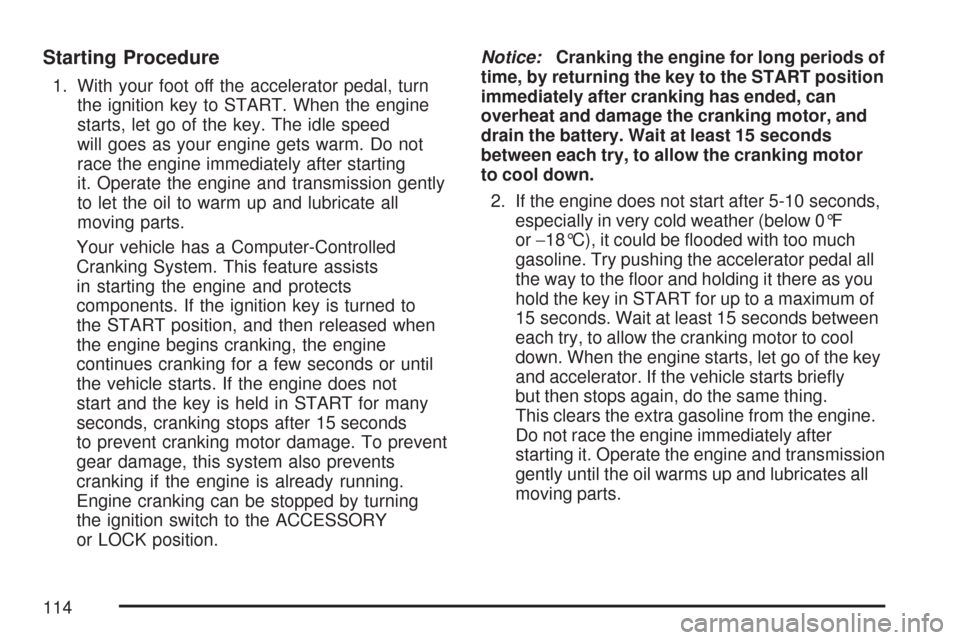
Starting Procedure
1. With your foot off the accelerator pedal, turn
the ignition key to START. When the engine
starts, let go of the key. The idle speed
will goes as your engine gets warm. Do not
race the engine immediately after starting
it. Operate the engine and transmission gently
to let the oil to warm up and lubricate all
moving parts.
Your vehicle has a Computer-Controlled
Cranking System. This feature assists
in starting the engine and protects
components. If the ignition key is turned to
the START position, and then released when
the engine begins cranking, the engine
continues cranking for a few seconds or until
the vehicle starts. If the engine does not
start and the key is held in START for many
seconds, cranking stops after 15 seconds
to prevent cranking motor damage. To prevent
gear damage, this system also prevents
cranking if the engine is already running.
Engine cranking can be stopped by turning
the ignition switch to the ACCESSORY
or LOCK position.Notice:Cranking the engine for long periods of
time, by returning the key to the START position
immediately after cranking has ended, can
overheat and damage the cranking motor, and
drain the battery. Wait at least 15 seconds
between each try, to allow the cranking motor
to cool down.
2. If the engine does not start after 5-10 seconds,
especially in very cold weather (below 0°F
or−18°C), it could be �ooded with too much
gasoline. Try pushing the accelerator pedal all
the way to the �oor and holding it there as you
hold the key in START for up to a maximum of
15 seconds. Wait at least 15 seconds between
each try, to allow the cranking motor to cool
down. When the engine starts, let go of the key
and accelerator. If the vehicle starts brie�y
but then stops again, do the same thing.
This clears the extra gasoline from the engine.
Do not race the engine immediately after
starting it. Operate the engine and transmission
gently until the oil warms up and lubricates all
moving parts.
114
Page 117 of 574
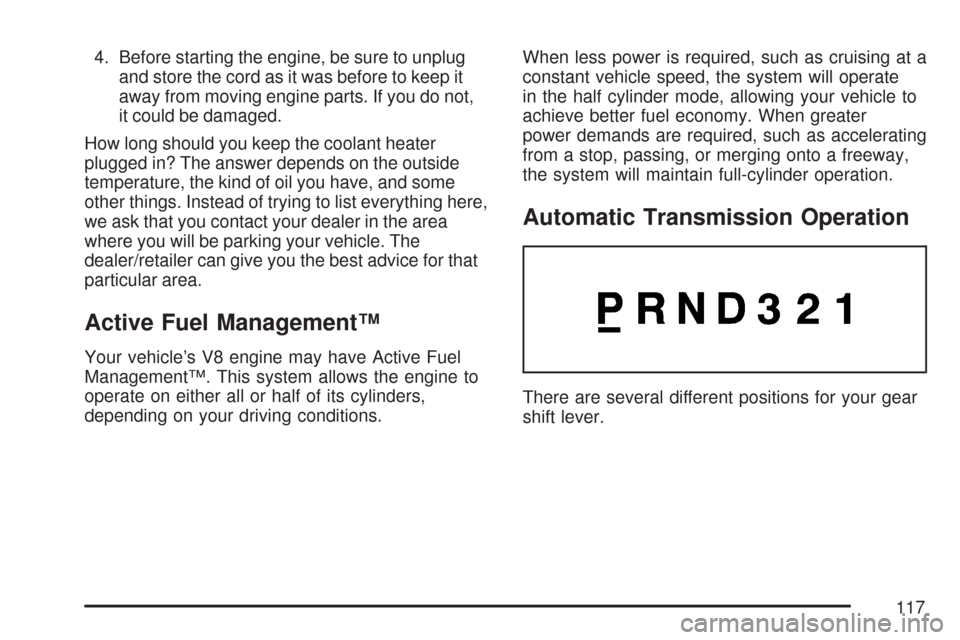
4. Before starting the engine, be sure to unplug
and store the cord as it was before to keep it
away from moving engine parts. If you do not,
it could be damaged.
How long should you keep the coolant heater
plugged in? The answer depends on the outside
temperature, the kind of oil you have, and some
other things. Instead of trying to list everything here,
we ask that you contact your dealer in the area
where you will be parking your vehicle. The
dealer/retailer can give you the best advice for that
particular area.
Active Fuel Management™
Your vehicle’s V8 engine may have Active Fuel
Management™. This system allows the engine to
operate on either all or half of its cylinders,
depending on your driving conditions.When less power is required, such as cruising at a
constant vehicle speed, the system will operate
in the half cylinder mode, allowing your vehicle to
achieve better fuel economy. When greater
power demands are required, such as accelerating
from a stop, passing, or merging onto a freeway,
the system will maintain full-cylinder operation.
Automatic Transmission Operation
There are several different positions for your gear
shift lever.
117
Page 378 of 574
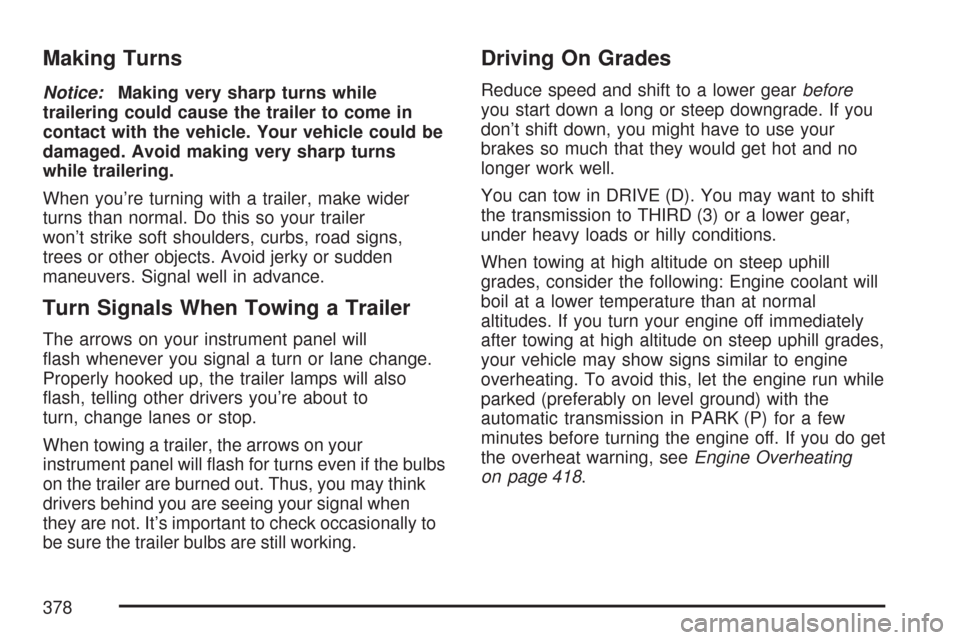
Making Turns
Notice:Making very sharp turns while
trailering could cause the trailer to come in
contact with the vehicle. Your vehicle could be
damaged. Avoid making very sharp turns
while trailering.
When you’re turning with a trailer, make wider
turns than normal. Do this so your trailer
won’t strike soft shoulders, curbs, road signs,
trees or other objects. Avoid jerky or sudden
maneuvers. Signal well in advance.
Turn Signals When Towing a Trailer
The arrows on your instrument panel will
�ash whenever you signal a turn or lane change.
Properly hooked up, the trailer lamps will also
�ash, telling other drivers you’re about to
turn, change lanes or stop.
When towing a trailer, the arrows on your
instrument panel will �ash for turns even if the bulbs
on the trailer are burned out. Thus, you may think
drivers behind you are seeing your signal when
they are not. It’s important to check occasionally to
be sure the trailer bulbs are still working.
Driving On Grades
Reduce speed and shift to a lower gearbefore
you start down a long or steep downgrade. If you
don’t shift down, you might have to use your
brakes so much that they would get hot and no
longer work well.
You can tow in DRIVE (D). You may want to shift
the transmission to THIRD (3) or a lower gear,
under heavy loads or hilly conditions.
When towing at high altitude on steep uphill
grades, consider the following: Engine coolant will
boil at a lower temperature than at normal
altitudes. If you turn your engine off immediately
after towing at high altitude on steep uphill grades,
your vehicle may show signs similar to engine
overheating. To avoid this, let the engine run while
parked (preferably on level ground) with the
automatic transmission in PARK (P) for a few
minutes before turning the engine off. If you do get
the overheat warning, seeEngine Overheating
on page 418.
378
Page 380 of 574
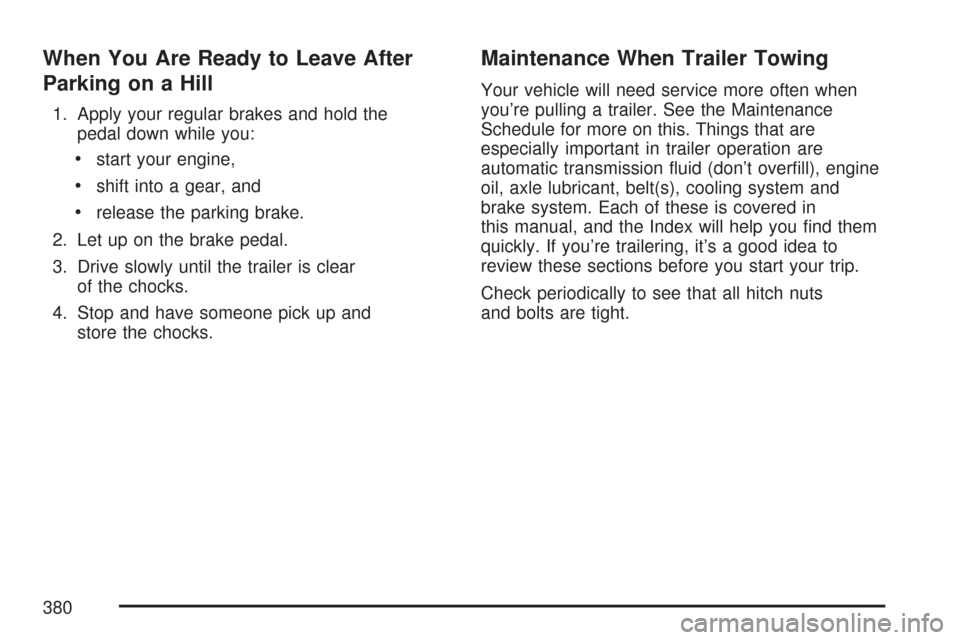
When You Are Ready to Leave After
Parking on a Hill
1. Apply your regular brakes and hold the
pedal down while you:
start your engine,
shift into a gear, and
release the parking brake.
2. Let up on the brake pedal.
3. Drive slowly until the trailer is clear
of the chocks.
4. Stop and have someone pick up and
store the chocks.
Maintenance When Trailer Towing
Your vehicle will need service more often when
you’re pulling a trailer. See the Maintenance
Schedule for more on this. Things that are
especially important in trailer operation are
automatic transmission �uid (don’t over�ll), engine
oil, axle lubricant, belt(s), cooling system and
brake system. Each of these is covered in
this manual, and the Index will help you �nd them
quickly. If you’re trailering, it’s a good idea to
review these sections before you start your trip.
Check periodically to see that all hitch nuts
and bolts are tight.
380
Page 383 of 574
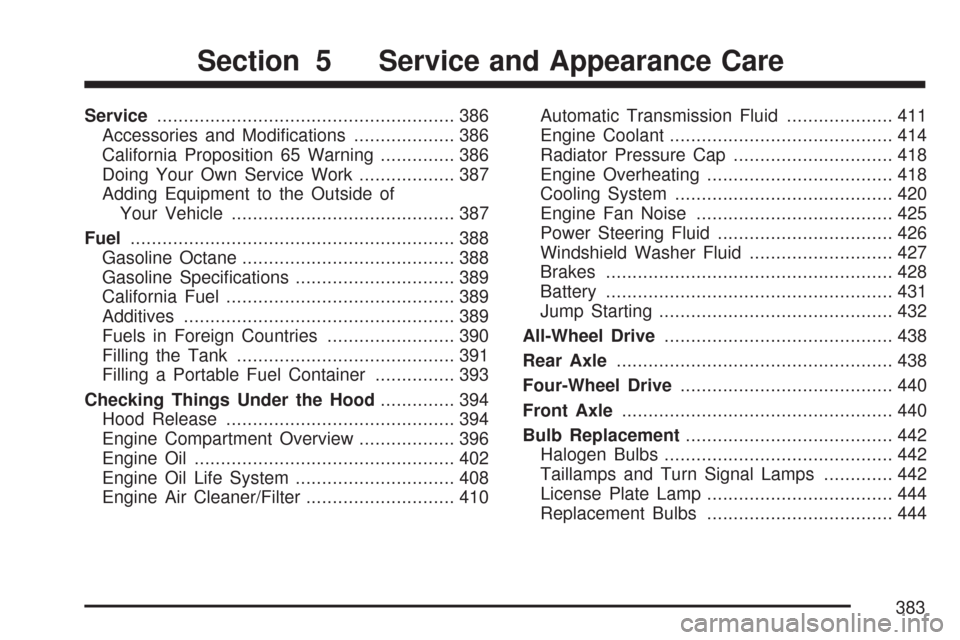
Service........................................................ 386
Accessories and Modi�cations................... 386
California Proposition 65 Warning.............. 386
Doing Your Own Service Work.................. 387
Adding Equipment to the Outside of
Your Vehicle.......................................... 387
Fuel............................................................. 388
Gasoline Octane........................................ 388
Gasoline Speci�cations.............................. 389
California Fuel........................................... 389
Additives................................................... 389
Fuels in Foreign Countries........................ 390
Filling the Tank......................................... 391
Filling a Portable Fuel Container............... 393
Checking Things Under the Hood.............. 394
Hood Release........................................... 394
Engine Compartment Overview.................. 396
Engine Oil................................................. 402
Engine Oil Life System.............................. 408
Engine Air Cleaner/Filter............................ 410Automatic Transmission Fluid.................... 411
Engine Coolant.......................................... 414
Radiator Pressure Cap.............................. 418
Engine Overheating................................... 418
Cooling System......................................... 420
Engine Fan Noise..................................... 425
Power Steering Fluid................................. 426
Windshield Washer Fluid........................... 427
Brakes...................................................... 428
Battery...................................................... 431
Jump Starting............................................ 432
All-Wheel Drive........................................... 438
Rear Axle.................................................... 438
Four-Wheel Drive........................................ 440
Front Axle................................................... 440
Bulb Replacement....................................... 442
Halogen Bulbs........................................... 442
Taillamps and Turn Signal Lamps............. 442
License Plate Lamp................................... 444
Replacement Bulbs................................... 444
Section 5 Service and Appearance Care
383
Page 397 of 574
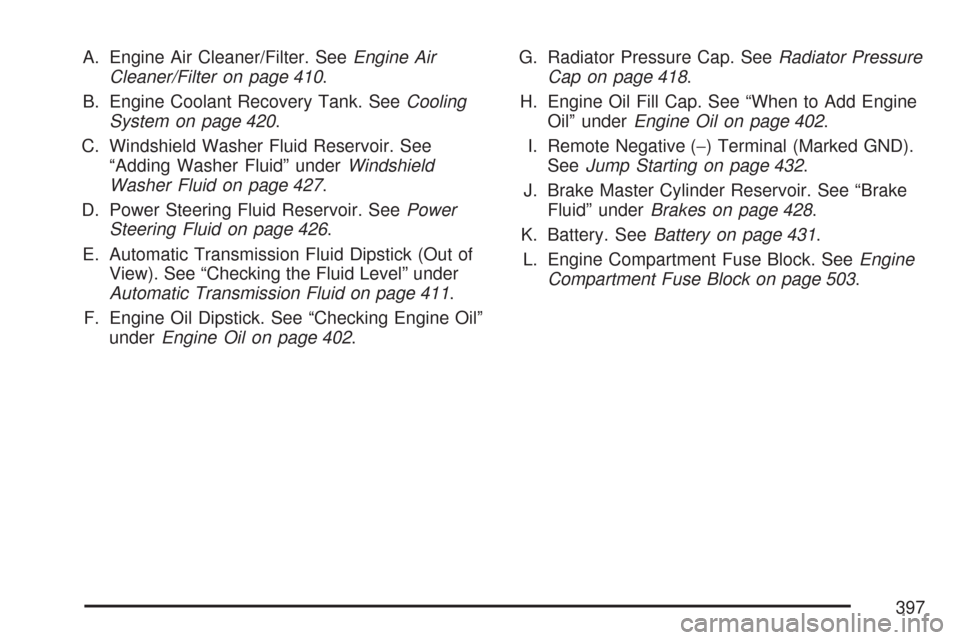
A. Engine Air Cleaner/Filter. SeeEngine Air
Cleaner/Filter on page 410.
B. Engine Coolant Recovery Tank. SeeCooling
System on page 420.
C. Windshield Washer Fluid Reservoir. See
“Adding Washer Fluid” underWindshield
Washer Fluid on page 427.
D. Power Steering Fluid Reservoir. SeePower
Steering Fluid on page 426.
E. Automatic Transmission Fluid Dipstick (Out of
View). See “Checking the Fluid Level” under
Automatic Transmission Fluid on page 411.
F. Engine Oil Dipstick. See “Checking Engine Oil”
underEngine Oil on page 402.G. Radiator Pressure Cap. SeeRadiator Pressure
Cap on page 418.
H. Engine Oil Fill Cap. See “When to Add Engine
Oil” underEngine Oil on page 402.
I. Remote Negative (−) Terminal (Marked GND).
SeeJump Starting on page 432.
J. Brake Master Cylinder Reservoir. See “Brake
Fluid” underBrakes on page 428.
K. Battery. SeeBattery on page 431.
L. Engine Compartment Fuse Block. SeeEngine
Compartment Fuse Block on page 503.
397
Page 399 of 574
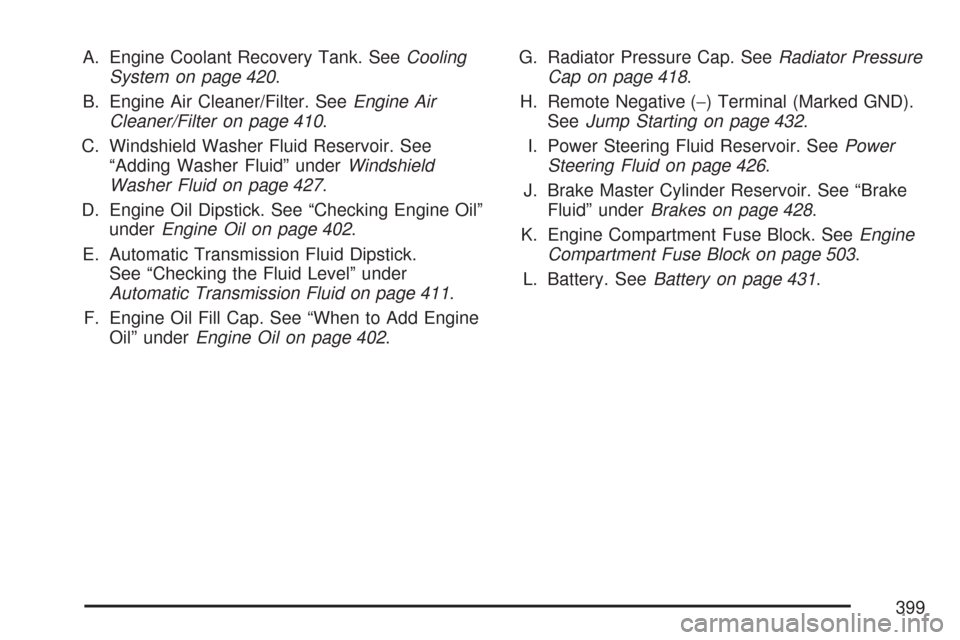
A. Engine Coolant Recovery Tank. SeeCooling
System on page 420.
B. Engine Air Cleaner/Filter. SeeEngine Air
Cleaner/Filter on page 410.
C. Windshield Washer Fluid Reservoir. See
“Adding Washer Fluid” underWindshield
Washer Fluid on page 427.
D. Engine Oil Dipstick. See “Checking Engine Oil”
underEngine Oil on page 402.
E. Automatic Transmission Fluid Dipstick.
See “Checking the Fluid Level” under
Automatic Transmission Fluid on page 411.
F. Engine Oil Fill Cap. See “When to Add Engine
Oil” underEngine Oil on page 402.G. Radiator Pressure Cap. SeeRadiator Pressure
Cap on page 418.
H. Remote Negative (−) Terminal (Marked GND).
SeeJump Starting on page 432.
I. Power Steering Fluid Reservoir. SeePower
Steering Fluid on page 426.
J. Brake Master Cylinder Reservoir. See “Brake
Fluid” underBrakes on page 428.
K. Engine Compartment Fuse Block. SeeEngine
Compartment Fuse Block on page 503.
L. Battery. SeeBattery on page 431.
399
Page 401 of 574
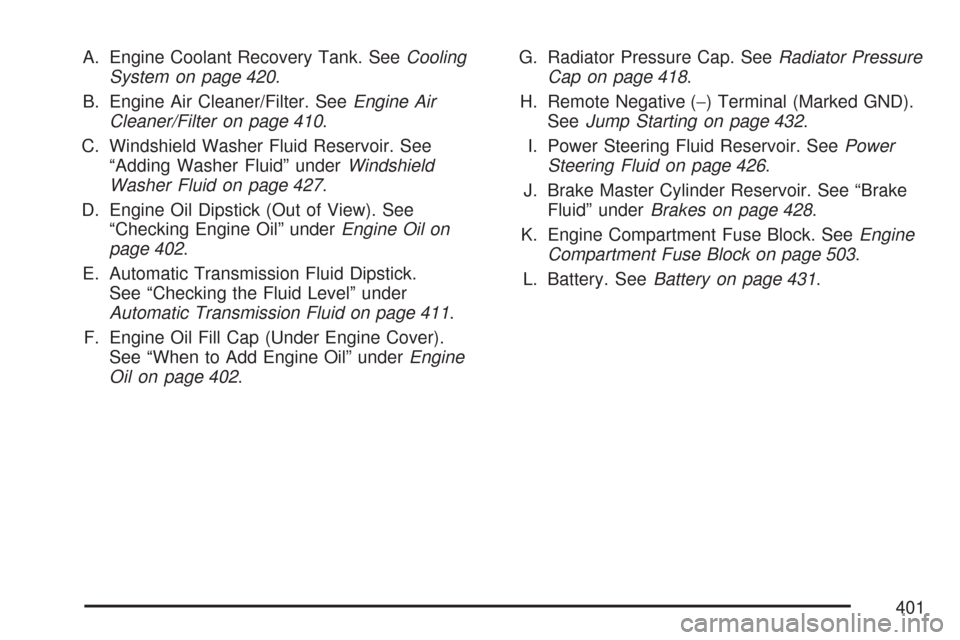
A. Engine Coolant Recovery Tank. SeeCooling
System on page 420.
B. Engine Air Cleaner/Filter. SeeEngine Air
Cleaner/Filter on page 410.
C. Windshield Washer Fluid Reservoir. See
“Adding Washer Fluid” underWindshield
Washer Fluid on page 427.
D. Engine Oil Dipstick (Out of View). See
“Checking Engine Oil” underEngine Oil on
page 402.
E. Automatic Transmission Fluid Dipstick.
See “Checking the Fluid Level” under
Automatic Transmission Fluid on page 411.
F. Engine Oil Fill Cap (Under Engine Cover).
See “When to Add Engine Oil” underEngine
Oil on page 402.G. Radiator Pressure Cap. SeeRadiator Pressure
Cap on page 418.
H. Remote Negative (−) Terminal (Marked GND).
SeeJump Starting on page 432.
I. Power Steering Fluid Reservoir. SeePower
Steering Fluid on page 426.
J. Brake Master Cylinder Reservoir. See “Brake
Fluid” underBrakes on page 428.
K. Engine Compartment Fuse Block. SeeEngine
Compartment Fuse Block on page 503.
L. Battery. SeeBattery on page 431.
401
Page 411 of 574
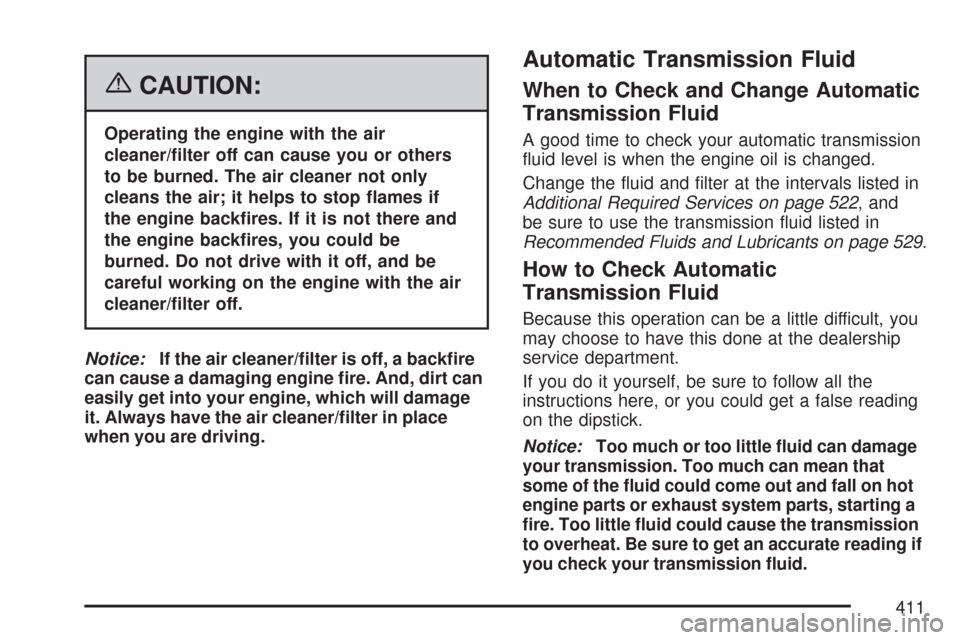
{CAUTION:
Operating the engine with the air
cleaner/�lter off can cause you or others
to be burned. The air cleaner not only
cleans the air; it helps to stop �ames if
the engine back�res. If it is not there and
the engine back�res, you could be
burned. Do not drive with it off, and be
careful working on the engine with the air
cleaner/�lter off.
Notice:If the air cleaner/�lter is off, a back�re
can cause a damaging engine �re. And, dirt can
easily get into your engine, which will damage
it. Always have the air cleaner/�lter in place
when you are driving.
Automatic Transmission Fluid
When to Check and Change Automatic
Transmission Fluid
A good time to check your automatic transmission
�uid level is when the engine oil is changed.
Change the �uid and �lter at the intervals listed in
Additional Required Services on page 522, and
be sure to use the transmission �uid listed in
Recommended Fluids and Lubricants on page 529.
How to Check Automatic
Transmission Fluid
Because this operation can be a little difficult, you
may choose to have this done at the dealership
service department.
If you do it yourself, be sure to follow all the
instructions here, or you could get a false reading
on the dipstick.
Notice:Too much or too little �uid can damage
your transmission. Too much can mean that
some of the �uid could come out and fall on hot
engine parts or exhaust system parts, starting a
�re. Too little �uid could cause the transmission
to overheat. Be sure to get an accurate reading if
you check your transmission �uid.
411
Page 414 of 574
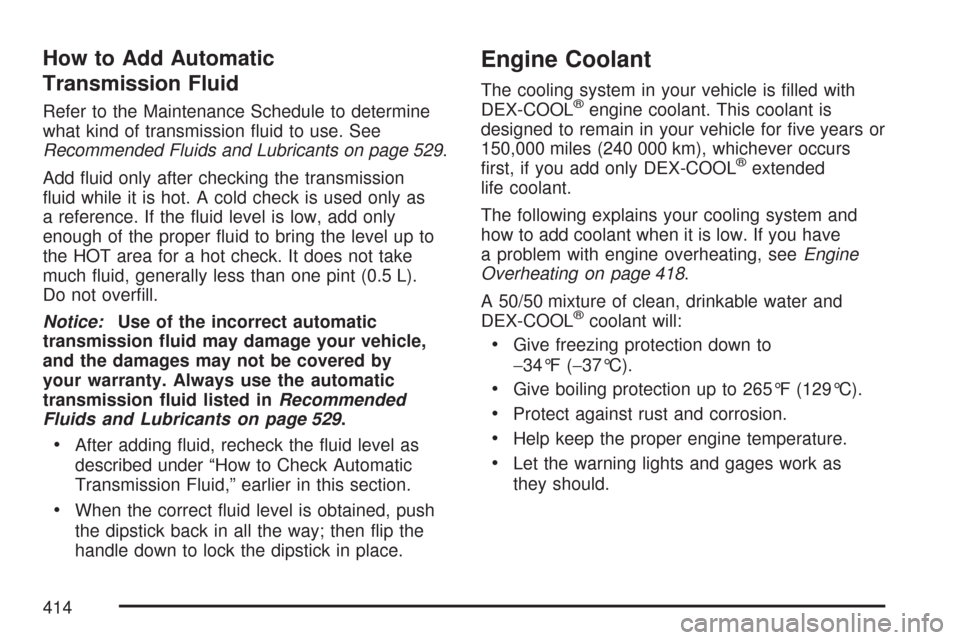
How to Add Automatic
Transmission Fluid
Refer to the Maintenance Schedule to determine
what kind of transmission �uid to use. See
Recommended Fluids and Lubricants on page 529.
Add �uid only after checking the transmission
�uid while it is hot. A cold check is used only as
a reference. If the �uid level is low, add only
enough of the proper �uid to bring the level up to
the HOT area for a hot check. It does not take
much �uid, generally less than one pint (0.5 L).
Do not over�ll.
Notice:Use of the incorrect automatic
transmission �uid may damage your vehicle,
and the damages may not be covered by
your warranty. Always use the automatic
transmission �uid listed inRecommended
Fluids and Lubricants on page 529.
After adding �uid, recheck the �uid level as
described under “How to Check Automatic
Transmission Fluid,” earlier in this section.
When the correct �uid level is obtained, push
the dipstick back in all the way; then �ip the
handle down to lock the dipstick in place.
Engine Coolant
The cooling system in your vehicle is �lled with
DEX-COOL®engine coolant. This coolant is
designed to remain in your vehicle for �ve years or
150,000 miles (240 000 km), whichever occurs
�rst, if you add only DEX-COOL
®extended
life coolant.
The following explains your cooling system and
how to add coolant when it is low. If you have
a problem with engine overheating, seeEngine
Overheating on page 418.
A 50/50 mixture of clean, drinkable water and
DEX-COOL
®coolant will:
Give freezing protection down to
−34°F (−37°C).
Give boiling protection up to 265°F (129°C).
Protect against rust and corrosion.
Help keep the proper engine temperature.
Let the warning lights and gages work as
they should.
414